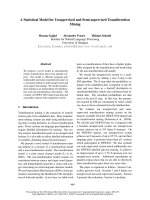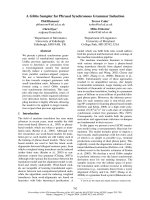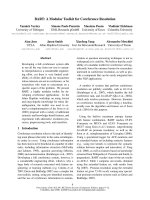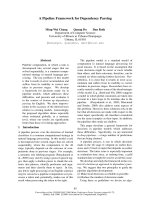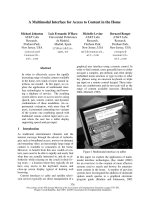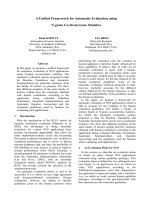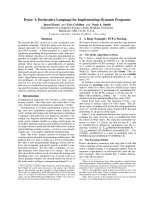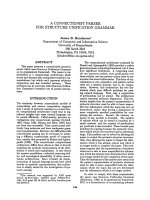Báo cáo khoa học: "A Portable Algorithm for Mapping Bitext Correspondence" pptx
Bạn đang xem bản rút gọn của tài liệu. Xem và tải ngay bản đầy đủ của tài liệu tại đây (712.36 KB, 8 trang )
A Portable Algorithm for Mapping Bitext Correspondence
I. Dan Melamed
Dept. of Computer and Information Science
University of Pennsylvania
Philadelphia, PA, 19104, U.S.A.
melamed@unagi, cis. upenn, edu
Abstract
The first step in most empirical work in
multilingual NLP is to construct maps of
the correspondence between texts and their
translations (bitext maps). The Smooth
Injective Map Recognizer (SIMR) algo-
rithm presented here is a generic pattern
recognition algorithm that is particularly
well-suited to mapping bitext correspon-
dence. SIMR is faster and significantly
more accurate than other algorithms in the
literature. The algorithm is robust enough
to use on noisy texts, such as those result-
ing from OCR input, and on translations
that are not very literal. SIMR encap-
sulates its language-specific heuristics, so
that it can be ported to any language pair
with a minimal effort.
1 Introduction
Texts that are available in two languages (bitexts)
are immensely valuable for many natural language
processing applications z. Bitexts are the raw ma-
terial from which translation models are built. In
addition to their use in machine translation (Sato
& Nagao, 1990; Brown et al., 1993; Melamed,
1997), translation models can be applied to machine-
assisted translation (Sato, 1992; Foster et al., 1996),
cross-lingual information retrieval (SIGIR, 1996),
and gisting of World Wide Web pages (Resnik,
1997). Bitexts also play a role in less auto-
mated applications such as concordancing for bilin-
gual lexicography (Catizone et al., 1993; Gale &
Church, 1991b), computer-assisted language learn-
ing, and tools for translators (e.g. (Macklovitch,
1 "Multitexts" in more than two languages are even
more valuable, but they are much more rare.
1995; Melamed, 1996b). However, bitexts are of lit-
tle use without an automatic method for construct-
ing bitext maps.
Bitext maps identify corresponding text units be-
tween the two halves of a bitext. The ideal bitext
mapping algorithm should be fast and accurate, use
little memory and degrade gracefully when faced
with translation irregularities like omissions and in.
versions. It should be applicable to any text genre
in any pair of languages.
The Smooth Injective Map Recognizer (SIMR) al-
gorithm presented in this paper is a bitext mapping
algorithm that advances the state of the art on these
criteria. The evaluation in Section 5 shows that
SIMR's error rates are lower than those of other
bitext mapping algorithms by an order of magni-
tude. At the same time, its expected running time
and memory requirements are linear in the size of the
input, better than any other published algorithm.
The paper begins by laying down SIMR's geomet-
ric foundations and describing the algorithm. Then,
Section 4 explains how to port SIMR to arbitrary
language pairs with minimal effort, without rely-
ing on genre-specific information such as sentence
boundaries. The last section offers some insights
about the optimal level of text analysis for mapping
bitext correspondence.
2 Bitext Geometry
A bitext (Harris, 1988) comprises two versions of
a text, such as a text in two different languages.
Translators create a bitext each time they trans-
late a text. Each bitext defines a rectangular
bitext space, as illustrated in Figure 1. The width
and height of the rectangle are the lengths of the
two component texts, in characters. The lower left
corner of the rectangle is the origin of the bitext
space and represents the two texts' beginnings. The
upper right corner is the terminus and represents
the texts' ends. The line between the origin and the
305
II
origin
terminus
diagonal
x = character position in text 1
Figure 1: a bitext space
terminus is the main diagonal. The slope of the
main diagonal is the bitext slope.
Each bitext space contains a number of true
points of correspondence (TPCs), other than
the origin and the terminus. For example, if a token
at position p on the x-axis and a token at position
q on the y-axis are translations of each other, then
the coordinate (p, q) in the bitext space is a TPC 2.
TPCs also exist at corresponding boundaries of text
units such as sentences, paragraphs, and chapters.
Groups of TPCs with a roughly linear arrangement
in the bitext space are called chains.
Bitext maps are 1-to-1 functions in bitext
spaces. A complete set of TPCs for a particular
bitext is called a true bitext map (TBM). The
purpose of a bitext mapping algorithm is to pro-
duce bitext maps that are the best possible approx-
imations of each bitext's TBM.
3 SIMR
SIMR builds bitext maps one chain at a time. The
search for each chain alternates between a genera-
tion phase and a recognition phase. The genera-
tion phase begins in a small rectangular region of
the bitext space, whose diagonal is parallel to the
main diagonal. Within this search rectangle, SIMR
generates all the points of correspondence that sat-
isfy the supplied matching predicate, as explained
in Section 3.1. In the recognition phase, SIMR
calls the chain recognition heuristic to find suitable
chains among the generated points. If no suitable
chains are found, the search rectangle is proportion-
ally expanded and the generation-recognition cycle
2Since distances in the bitext space are measured in
characters, the position of a token is defined as the mean
position of its characters.
is repeated. The rectangle keeps expanding until at
least one acceptable chain is found. If more than
one chain is found in the same cycle, SIMR accepts
the one whose points are least dispersed around its
least-squares line. Each time SIMR accepts a chain,
it selects another region of the bitext space to search
for the next chain.
SIMR employs a simple heuristic to select regions
of the bitext space to search. To a first approxima-
tion, TBMs are monotonically increasing functions.
This means that if SIMR finds one chain, it should
look for others either above and to the right or below
and to the left of the one it has just found. All SIMR
needs is a place to start the trace. A good place to
start is at the beginning: Since the origin of the
bitext space is always a TPC, the first search rect-
angle is anchored at the origin. Subsequent search
rectangles are anchored at the top right corner of
the previously found chain, as shown in Figure 2.
I e discovered TPC 1 next ~ o
o undiscovered TPC TPC~J
• • previous chain ®
Figure 2:
S[MR's "expanding rectangle" search
strategy. The search rectangle is anchored at the top
right corner of the previously found chain. Its diag-
onal remains parallel to the main diagonal.
The expanding-rectangle search strategy makes
SIMR robust in the face of TBM discontinuities.
Figure 2 shows a segment of the TBM that contains
a vertical gap (an omission in the text on the x-axis).
As the search rectangle grows, it will eventually in-
tersect with the TBM, even if the discontinuity is
quite large (Melamed, 1996b). The noise filter de-
scribed in Section 3.3 prevents SIMR from being led
astray by false points of correspondence.
3.1 Point Generation
SIMR generates candidate points of correspondence
in the search rectangle using one of its matching
predicates. A matching predicate is a heuristic
for deciding whether a given pair of tokens are likely
to be'mutual translations. Two kinds of information
306
that a matching predicate can rely on most often are
cognates and translation lexicons.
Two tokens in a bitext are cognates if they have
the same meaning and similar spellings. In the non-
technical Canadian Hansards (parliamentary debate
transcripts available in English and in French), cog-
nates can be found for roughly one quarter of all
text tokens (Melamed, 1995). Even distantly related
languages like English and Czech will share a large
number of cognates in the form of proper nouns.
Cognates are more common in bitexts from more
similar language pairs, and from text genres where
more word borrowing occurs, such as technical texts.
When dealing with language pairs that have dissim-
ilar alphabets, the matching predicate can employ
phonetic cognates (Melamed, 1996a). When one
or both of the languages involved is written in pic-
tographs, cognates can still be found among punc-
tuation and digit strings. However, cognates of this
last kind are usually too sparse to suffice by them-
selves.
When the matching predicate cannot generate
enough candidate correspondence points based on
cognates, its signal can be strengthened by a trans-
lation lexicon. Translation lexicons can be ex-
tracted from machine-readable bilingual dictionaries
(MRBDs), in the rare cases where MRBDs are avail-
able. In other cases, they can be constructed auto-
matically or semi-automatically using any of several
methods (Fung, 1995; Melamed, 1996c; Resnik &
Melamed, 1997). Since the matching predicate need
not be perfectly accurate, the translation lexicons
need not be either.
Matching predicates can take advantage of other
information, besides cognates and translation lexi-
cons can also be used. For example, a list of
faux
amis
is a useful complement to a cognate matching
strategy (Macklovitch, 1995). A stop list of function
words is also helpful. Function words are translated
inconsistently and make unreliable points of corre-
spondence (Melamed, 1996a).
3.2 Point Selection
As illustrated in Figure 2, even short sequences of
TPCs form characteristic patterns. Most chains of
TPCs have the following properties:
• Linearity: TPCs tend to line up straight.
• Low Variance of Slope: The slope of a TPC
chain is rarely much different from the bitext
slope.
• Injectivity: No two points in a chain of TPCs
can have the same x- or y-co-ordinates.
SIMR's chain recognition heuristic exploits these
properties to decide which chains in the search rect-
angle might be TPC chains.
The heuristic involves three parameters: chain
size, maximum point dispersal and maximum
angle deviation. A chain's size is simply the num-
ber of points it contains. The heuristic considers
only chains of exactly the specified size whose points
are injective. The linearity of the these chains is
tested by measuring the root mean squared distance
of the chain's points from the chain's least-squares
line. If this distance exceeds the maximum point
dispersal threshold, the chain is rejected. Next, the
angle of each chain's least-squares line is compared
to the arctangent of the bitext slope. If the differ-
ence exceeds the maximum angle deviation thresh-
old, the chain is rejected. These filters can be effi-
ciently combined so that SIMR's expected running
time and memory requirements are linear in the size
of the input bitext (Melamed, 1996a).
The chain recognition heuristic pays no attention
to whether chains are monotonic. Non-monotonic
TPC chains are quite common, because even lan-
guages with similar syntax like French and English
have well-known differences in word order. For ex-
ample, English (adjective, noun) pairs usually corre-
spond to French (noun, adjective) pairs. Such inver-
sions result in TPCs arranged like the middle two
points in the "previous chain" of Figure 2. SIMR
has no problem accepting the inverted points.
If the order of words in a certain text passage is
radically altered during translation, SIMR will sim-
ply ignore the words that "move too much" and con-
struct chains out of those that remain more station-
ary. The maximum point dispersal parameter lim-
its the width of accepted chains, but nothing lim-
its their length. In practice, the chain recognition
heuristic often accepts chains that span several sen-
tences. The ability to analyze non-monotonic points
of correspondence over variable-size areas of bitext
space makes SIMR robust enough to use on transla-
tions that are not very literal.
3.3 Noise Filter
Points of correspondence among frequent token
types often line up in rows and columns, as illus-
trated in Figure 3. Token types like the English
article "a" can produce one or more correspondence
points for almost every sentence in the opposite text.
Only one point of correspondence in each row and
column can be correct; the rest are noise. A noise fil-
ter can make it easier for SIMR to find TPC chains.
Other bitext mapping algorithms mitigate this
source of noise either by assigning lower weights to
307
a
a
a
a
"" a
c-
.ca a
c
I.U
ql
ii
• qD
• • q,
Q •
qD
~ 'a
French text
Figure 3: Frequent tokens cause false points of cor-
respondence that line up in rows and columns.
correspondence points associated with frequent to-
ken types (Church, 1993) or by deleting frequent to-
ken types from the bitext altogether (Dagan et al.,
1993). However, a token type that is relatively fre-
quent overall can be rare in some parts of the text.
In those parts, the token type can provide valuable
clues to correspondence. On the other hand, many
tokens of a relatively rare type can be concentrated
in a short segment of the text, resulting in many
false correspondence points. The varying concentra-
tion of identical tokens suggests that more localized
noise filters would be more effective. SIMR's local-
ized search strategy provides a vehicle for a localized
noise filter.
The filter is based on the maximum point am-
biguity level parameter. For each point p = (x, y),
lct X be the number of points in column x within
the search rectangle, and let Y be the number of
points in row y within the search rectangle. Then
the ambiguity level of p is X + Y - 2. In partic-
ular, if p is the only point in its row and column,
then its ambiguity level is zero. The chain recogni-
tion heuristic ignores points whose ambiguity level is
too high. What makes this a localized filter is that
only points within the search rectangle count toward
each other's ambiguity level. The ambiguity level of
a given point can change when the search rectangle
expands or moves.
The noise filter ensures that false points of corre-
spondence are very sparse, as illustrated in Figure 4.
Even if one chain of false points of correspondence
slips by the chain recognition heuristic, the expand-
ing rectangle will find its way back to the TBM be-
fore the chain recognition heuristic accepts another
false
""
.,Z
°•
:~'~ anchor
off track
"
Figure 4: SIMR's noise filter ensures that TPCs
are much more dense than false points of correspon-
dence A good signal-to-noise ratio prevents SIMR
from getting lost.
chain. If the matching predicate generates a reason-
ably strong signal then the signal-to-noise ratio will
be high and SIMR will not get lost, even though it
is a greedy algorithm with no ability to look ahead.
4 Porting to New Language Pairs
SIMR can be ported to a new language pair in three
steps.
4.1 Step 1: Construct Matching Predicate
The original SIMR implementation for
French/English included matching predicates that
could use cognates and/or translation lexicons. For
language pairs in which lexical cognates are frequent,
a cognate-based matching predicate should suffice.
In other cases, a "seed" translation lexicon may be
used to boost the number of candidate points pro-
duced in the generation phase of the search. The
SIMR implementation for Spanish/English uses only
cognates. For Korean/English, SIMR takes advan-
tage of punctuation and number cognates but sup-
plements them with a small translation lexicon.
4.2 Step 2: Construct Axis Generators
In order for SIMR to generate candidate points of
correspondence, it needs to know what token pairs
correspond to co-ordinates in the search rectangle.
It is the axis generator's job to map the two halves
of the bitext to positions on the x- and y-axes of
the bitext space, before SIMR starts searching for
chains. This mapping should be done with the
matching predicate in mind.
If the matching predicate uses cognates, then ev-
ery word that might have a cognate in the other
half of the bitext should be assigned its own axis
308
position. This rule applies to punctuation and num-
bers as well as to "lexical" cognates. In the case of-
lexical cognates, the axis generator typically needs
to invoke a language-specific tokenization program
to identify words in the text. Writing such a pro-
gram may constitute a significant part of the port-
ing effort, if no such program is available in advance.
The effort may be lessened, however, by the realiza-
tion that it is acceptable for the tokenization pro-
gram to overgenerate just as it is acceptable for the
matching predicate. For example, when tokenizing
German text, it is not necessary for the tokenizer
to know which words are compounds. A word that
has another word as a substring should result in one
axis position for the substring and one for the su-
perstring.
When lexical cognates are not being used, the axis
generator only needs to identify punctuation, num-
bers, and those character strings in the text which
also appear on the relevant side of the translation
lexicon 3. It would be pointless to plot other words
on the axes because the matching predicate could
never match them anyway. Therefore, for languages
like Chinese and Japanese, which are written with-
out spaces between words, tokenization boils down
to string matching. In this manner, SIMR circum-
vents the difficult problem of word identification in
these languages.
4.3 Step 3: Re-optimize Parameters
The last step in the porting process is to re-optimize
SIMR's numerical parameters. The four parameters
described in Section 3 interact in complicated ways,
and it is impossible to find a good parameter set
analytically. It is easier to optimize these parameters
empirically, using simulated annealing (Vidal, 1993).
Simulated annealing requires an objective func-
tion to optimize. The objective function for bitext
mapping should measure the difference between the
TBM and maps produced with the current parame-
ter set. In geometric terms, the difference is a dis-
tance. The TBM consists of a set of TPCs. The
error between a bitext map and each TPC can be
defined as the horizontal distance, the vertical dis-
tance, or the distance perpendicular to the main di-
agonal. The first two alternatives would minimize
the error with respect to only one language or the
other. The perpendicular distance is a more robust
average. In order to penalize large errors more heav-
ily, root mean squared (RMS) distance is minimized
instead of mean distance.
3Multi-word expressions in the translation lexicon are
treated just like any other character string.
The most tedious part of the porting process is the
construction of TBMs against which SIMR's param-
eters can be optimized and tested. The easiest way
to construct these gold standards is to extract them
from pairs of hand-aligned text segments: The final
character positions of each segment in an aligned
pair are the co-ordinates of a TPC. Over the course
of two porting efforts, I have develol~ed and refined
tools and methods that allow a bilingual annota-
tor to construct the required TBMs very efficiently
from a raw bitext. For example, a tool originally de-
signed for automatic detection of omissions in trans-
lations (Melamed, 1996b) was adopted to detect mis-
alignments.
4.4 Porting Experience Summary
Table 1 summarizes the amount of time invested
in each new language pair. The estimated times
for building axis generators do not include the time
spent to build the English axis generator, which was
part of the original implementation. Axis generators
need to be built only once per language, rather than
once per language pair.
5 Evaluation
SIMR was evaluated on hand-aligned bitexts of vari-
ous genres in three language pairs. None of these test
bitexts were used anywhere in the training or port-
ing procedures. Each test bitext was converted to a
set of TPCs by noting the pair of character positions
at the end of each aligned pair of text segments. The
test metric was the root mean squared distance, in
characters, between each TPC and the interpolated
bitext map produced by SIMR, where the distance
was measured perpendicular to the main diagonal.
The results are presented in Table 2.
The French/English part of the evaluation was
performed on bitexts from the publicly available
BAF corpus created at CITI (Simard & Plamon-
don, 1996). SIMR's error distribution on the "parlia-
mentary debates" bitext in this collection is given in
Table 3. This distribution can be compared to error
distributions reported in (Church, 1993) and in (Da-
gan et al., 1993). SIMR's RMS error on this bitext
was 5.7 characters. Church's
char_align
algorithm
(Church, 1993) is the only algorithm that does not
use sentence boundary information for which com-
parable results have been reported, char_align's
RMS error on this bitext was 57 characters, exactly
ten times higher.
Two teams of researchers have reported results
on the same "parliamentary debates" bitext for al-
gorithms that map correspondence at the sentence
level (Gale & Church, 1991a; Simard et al., 1992).
309
Table 1: Time spent in constructing two "gold standard" TBMs.
estimated time estimated time
main informant for spent to build spent on
language pair matching predicate new axis generator hand-alignment
Spanish/English lexical cognates 8 h 5 h
Korean/English translation lexicon 6 h 12 h
number of
segments
aligned
1338
1224
Table 2: SIMR accuracy on different text genres in three language pairs.
language number of number of RMS Error
pair training TPCs genre test TPCs in characters
French / English 598
parliamentary debates
CITI technical reports
other technical reports
court transcripts
U.N. annual report
I.L.O. report
7123
365,305, 176
561, 1393
1377
2049
7129
5.7
4.4, 2.6, 9.9
20.6, 14.2
3.9
12.36
6.42
Spanish / English 562 software manuals 376, 151,100, 349 4.7, 1.3, 6.6, 4.9
Korean / English 615 military manuals 40, 88, 186, 299 2.6, 7.1, 25, 7.8
military messages 192 0.53
Table 3: SIMR 's error distribution on the
French/English "parliamentary debates" bitext.
number of error range fraction of
test points in characters test points
1
2
1
5
4
6
9
29
3057
3902
43
28
17
5
8
1
1
1
1
1
1
-101
-80 to -70
-70 to -60
-60 to -50
-50 to -40
-40 to -30
-30 to -20
-20 to -10
-10 to 0
0 to 10
10 to 20
20 to 30
30 to 40
40 to 50
50 to 60
60 to 70
70 to 80
80 to 90
90 to 100
110 to 120
185
.0001
.0003
.0001
.0007
.0006
.0008
.0013
.0041
.4292
.5478
.0060
.0039
.0024
.0007
.0011
.0001
.0001
.0001
.0001
.0001
.0001
7123 1.000
Both of these algorithms use sentence boundary
information. Melamed (1996a) showed that sen-
tence boundary information can be used to convert
SIMR's output into sentence alignments that are
more accurate than those obtained by either of the
other two approaches.
The test bitexts in the other two language pairs
were created when SIMR was being ported to those
languages. The Spanish/English bitexts were drawn
from the on-line Sun MicroSystems Solaris An-
swerBooks. The Korean/English bitexts were pro-
vided and hand-aligned by Young-Suk Lee of MIT's
Lincoln Laboratories. Although it is not possible
to compare SIMR's performance on these language
pairs to the performance of other algorithms, Table 2
shows that the performance on other language pairs
is no worse than performance on French/English.
6 Which Text Units to Map?
Early bitext mapping algorithms focused on sen-
tences (Kay & RSscheisen, 1993; Debili & Sam-
mouda, 1992). Although sentence maps do not have
sufficient resolution for some important bitext appli-
cations (Melamed, 1996b; Macklovitch, 1995), sen-
tences were an easy starting point, because their
order rarely changes during translation. Therefore,
sentence mapping algorithms need not worry about
crossing correspondences. In 1991, two teams of re-
searchers independently discovered that sentences
can be accurately aligned by matching sequences
310
with similar lengths (Gale & Church, 1991a; Brown
et al., 1991).
Soon thereafter, Church (1993) found that bitext
mapping at the sentence level is not an option for
noisy bitexts found in the real world. Sentences
are often difficult to detect, especially where punc-
tuation is missing due to OCR errors. More im-
portantly, bitexts often contain lists, tables, titles,
footnotes, citations and/or mark-up codes that foil
sentence alignment methods. Church's solution was
to look at the smallest of text units characters
and to use digital signal processing techniques
to grapple with the much larger number of text
units that might match between the two halves of
a bitext. Characters match across languages only to
the extent that they participate in cognates. Thus,
Church's method is only applicable to language pairs
with similar alphabets.
The main insight of the present work is that words
are a happy medium-sized text unit at which to map
bitext correspondence. By situating word positions
in a bitext space, the geometric heuristics of sen-
tence alignment algorithms can be exploited equally
well at the word level. The cognate heuristic of
the character-based algorithms works better at the
word level, because cognateness can be defined more
precisely in terms of words, e.g. using the Longest
Common Subsequence Ratio (Melamed, 1995). Sev-
eral other matching heuristics can only be applied
at the word level, including the localized noise filter
in Section 3.3, lists of stop words and lists of/aux
amis (Macklovitch, 1995). Most importantly, trans-
lation lexicons can only be used at the word level.
SIMR can employ a small hand-constructed transla-
tion lexicon to map bitexts in any pair of languages,
even when the cognate heuristic is not applicable and
sentences cannot be found. The particular combina-
tion of heuristics described in Section 3 can certainly
be improved on, but research into better bitext map-
ping algorithms is likely to be most fruitfull at the
word level.
7 Conclusion
The Smooth Injective Map Recognizer (SIMR)
bitext mapping algorithm advances the state of the
art on several frontiers. It is significantly more ac-
curate than other algorithms in the literature. Its
expected running time and memory requirements
are linear in the size of the input, which makes
it the algorithm of choice for very large bitexts.
It is not fazed by word order differences. It does
not rely on pre-segmented input and is portable to
any pair of languages with a minimal effort. These
features make SIMR the mostly widely applicable
bitext mapping algorithm to date.
SIMR opens up several new avenues of research.
One important application of bitext maps is the con-
struction of translation lexicons (Dagan et al., 1993)
and, as discussed, translation lexicons are an impor-
tant information source for bitext mapping. It is
likely that the accuracy of both kinds of algorithms
can be improved by alternating between the two on
the same bitext. There are also plans to build an
automatic bitext locating spider for the World Wide
Web, so that SIMR can be applied to more new lan-
guage pairs and bitext genres.
Acknowledgements
SIMR was ported to Spanish/English while I was
visiting Sun MicroSystems Laboratories. Thanks
to Gary Adams, Cookie Callahan, Bob Kuhns and
Philip Resnik for their help with that project.
Thanks also to Philip Resnik for writing the Spanish
tokenizer, and hand-aligning the Spanish/English
training bitexts. Porting SIMR to Korean/English
would not have been possible without Young-Suk
Lee of MIT's Lincoln Laboratories, who provided the
seed translation lexicon, and aligned all the training
and test bitexts. This paper was much improved
by helpful comments from Mitch Marcus, Adwait
Ratnaparkhi, Bonnie Webber and three anonymous
reviewers. This research was supported by an equip-
ment grant from Sun MicroSystems and by ARPA
Contract #N66001-94C-6043.
References
P. F. Brown, J. C. Lai & R. L. Mercer, "Aligning
Sentences in Parallel Corpora," Proceedings of the
29th Annual Meeting of the AsSociation for Com-
putational Linguistics, Berkeley, CA, 1991.
P. F. Brown, S. Della Pietra, V. Della Pietra, &
R. Mercer, "The Mathematics of Statistical Ma-
chine Translation: Parameter Estimation", Com-
putational Lin9uistics 19:2, 1993.
R. Catizone, G. Russell & S. Warwick "Deriving
Translation Data from Bilingual Texts," Proceed-
ings of the First International Lexical Acquisition
Workshop, Detroit, MI, 1993.
S. Chen, "Aligning Sentences in Bilingual Corpora
Using Lexical Information," Proceedings of the
31st Annual Meeting of the Association for Com-
putational Linguistics, Columbus, OH, 1993.
K. W. Church, "Char_align: A Program for Align-
ing Parallel Texts at the Character Level," Pro-
311
ceedings of the 31st Annual Meeting of the Asso-
ciation for Computational Linguistics, Columbus,
OH, 1993.
I. Dagan, K. Church, & W. Gale, "Robust Word
Alignment for Machine Aided Translation," Pro-
ceedings of the Workshop on Very Large Corpora:
Academic and Industrial Perspectives, Columbus,
OH, 1993.
F. Debili & E. Sammouda "Appariement des Phrases
de Textes Bilingues," Proceedings of the 14th
International Conference on Computational Lin-
guistics, Nantes, France, 1992.
G. Foster, P. Isabelle & P. Plamondon, "Word Com-
pletion: A First Step Toward Target-Text Medi-
ated IMT," Proceedings of the 16th International
Conference on Computational Linguistics, Copen-
hagen, Denmark, 1996.
P. Fung, "Compiling Bilingual Lexicon Entries from
a Non-Parallel English-Chinese Corpus," Proceed-
ings of the Third Workshop on Very Large Cor-
pora, Boston, MA, 1995.
W. Gale & K. W. Church, "A Program for Aligning
Sentences in Bilingual Corpora," Proceedings of
the 29th Annual Meeting o-f the Association for
Computational Linguistics, Berkeley, CA, 1991a.
W. Gale & K. W. Church, "Identifying Word Corre-
spondences in Parallel Texts," Proceedings of the
DARPA SNL Workshop, 1991b.
B. Harris, "Bi-Text, a New Concept in Translation
Theory," Language Monthly #54, 1988.
M. Kay & M. Rbscheisen "Text-Translation Align-
ment," Computational Linguistics 19:1, 1993.
E. Macklovitch, "Peut-on verifier automatiquement
la coherence terminologique?" Proceedings of the
IV es Journdes scientifiques, Lexicommatique et
Dictionnairiques, organized by AUPELF-UREF,
Lyon, France, 1995.
I. D. Melamed "Automatic Evaluation and Uniform
Filter Cascades for Inducing N-best Translation
Lexicons," Proceedings of the Third Workshop on
Very Large Corpora, Boston, MA, 1995.
I. D. Melamed, "A Geometric Approach to Mapping
Bitext Correspondence," Proceedings of the First
Conference on Empirical Methods in Natural Lan-
guage Processing (EMNLP'96), Philadelphia, PA,
1996a.
I. D. Melamed "Automatic Detection of Omissions
in Translations," Proceedings of the 16th Interna-
tional Conference on Computational Linguistics,
Copenhagen, Denmark, 1996b.
I. D. Metamed, "Automatic Construction of Clean
Broad-Coverage Translation Lexicons," Proceed-
ings of the Conference of the Association for
Machine Translation in the Americas, Montreal,
Canada, 1996c.
I. D. Melamed, "A Word-to-Word Model of Transla-
tional Equivalence," Proceedings of the 35th Con-
ference of the Association/or Computational Lin-
guistics, Madrid, Spain, 1997. (in this volume)
P. Resnik & I. D. Melamed, "Semi-Automatic Acqui-
sition of Domain-Specific Translation Lexicons,"
Proceedings of the 7th A CL Conference on Ap-
plied Natural Language Processing, Washington,
DC, 1997.
P. Resnik, "Evaluating Multilingual Gisting of Web
Pages," UMIACS-TR-97-39, University of Mary-
land, 1997.
S. Sato & M. Nagao, "Toward Memory-Based Trans-
lation," Proceedings of the 13th International
Conference on Computational Linguistics, 1990.
S. Sato, "CTM: An Example-Based Translation
Aid System," Proceedings of the 14th Interna-
tional Conference on Computational Linguistics,
Nantes, France, 1992.
SIGIR Workshop on Cross-linguistic Multilingual
Information Retrieval, Zurich, 1996.
M. Simard, G. F. Foster & P. Isabelle, "Using Cog-
nates to Align Sentences in Bilingual Corpora,"
in Proceedings of the Fourth International Con-
ference on Theoretical and Methodological Issues
in Machine Translation, Montreal, Canada, 1992.
M. Simard &: P. Plamondon, "Bilingual Sentence
Alignment: Balancing Robustness and Accuracy,"
Proceedings of the Conference of the Association
for Machine Translation in the Americas, Mon-
treal, Canada, 1996.
R. V. V. Vidal, Applied simulated Annealing,
Springer-Verlag, Heidelberg, Germany, 1993.
312

